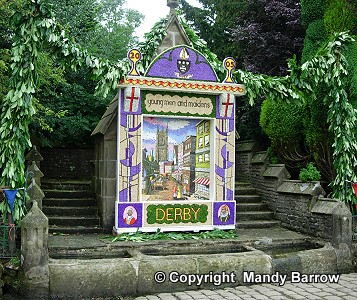
A decorated well in Derbyshire celebrates the fresh well water that allowed communities to survive before modern plumbing.
Romans named the sixth month of the year for JUNO, the queen of the Roman gods and goddesses. But the Anglo-Saxons called it Sera Monath (“Dry Month”) which was as much a hope as a weather prediction. Juno, however, is associated with roses and weddings and that—together with graduations—is what most modern people associate with June.
If June was the Dry Month in Anglo-Saxon areas, then it was important in many places to celebrate the water that was available. People began to celebrate “well dressings” in June to honor the underground springs of fresh water that sustain rural communities and urban neighborhoods. These well dressings are mostly parties now but in ancient or medieval times before plumbing celebrated the survival of communities and neighborhoods thanks to the available water. (See photos of making well dressing decorations here.)
Wells were thought to be the homes of nixies and water sprites, most of whom were friendly but some might be mischeivous or downright nasty to people that came to draw water from the well. Children, however, that fell into the well and drowned were almost always said to have been stolen by the nixie or sprite in the well.
